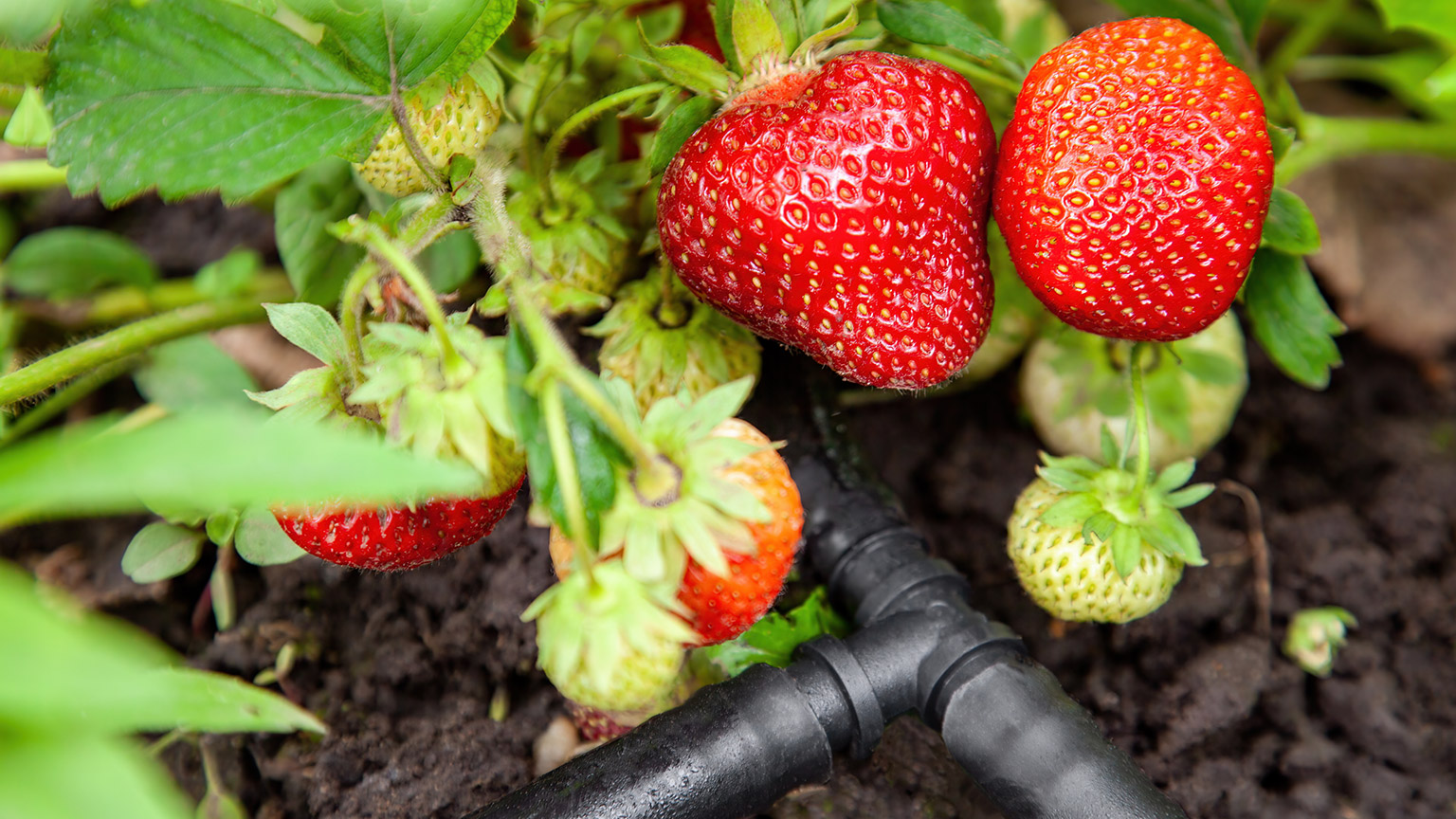These strawberry plants (Fragaria × ananassa) are being watered by a drip irrigation system.
As we know, plants need water, and sometimes – particularly during those hot, dry summers – the rain just isn’t enough. At these times, we need to irrigate (water) the plants ourselves. In this topic, we go beyond the basics of watering by introducing some low-tech irrigation systems you might want to consider setting up in your garden.
Plant water requirements
Water is needed for a number of different plant processes.
- Photosynthesis – turning sunlight and water into food in the form of stored energy.
- Transpirational pull – the suction created in the plant when water evaporates from the leaves which pulls more water from the roots up to other parts of the plant.
- Osmosis – the transfer of water (with dissolved nutrients) from the soil into the plant through its roots.
- Root pressure – pushes water up the stem to branches and leaves at lower levels of the plant.
- Seed germination – where a seed sprouts and forms its first roots, shoots and leaves.
It’s also important for healthy soil and compost.
As we can see, water is critical to the development and growth of plants throughout their life, and the for the health of our growing medium.
Signs of over and underwatering
The important thing is to water our plants when they need it. The best way to do this is to observe your plants carefully.
Overwatering is a common plant problem, particularly in heavy or poorly draining soils. The cause of overwatering can be frequent heavy rain or over-irrigating plants. When there is too much water in the soil, the air is pushed out of the pore spaces, and the plant roots don’t have access to the oxygen they need to work properly, such as for cellular respiration.
Signs of overwatering include:
- plant growth slows down (we call this a loss of vigor)
- both young and old leaves become yellow
- plants may suffer from leaf burn, which presents as “browning of plant tissues, including leaf margins and tips, and yellowing or darkening of veins” (Wikipedia contributors, 2023d)
- water-soaked spots may appear on stems and leaves (Missouri Botanical Garden, n.d.).
These differ from the signs of water stress (not having enough water) which include:
- leaves may change from glossy to dull.
- plants wilt or stop growing.
- crop production reduces.
- leaves, flowers, and buds become discoloured.
- bare patches appear in surrounding grass and groundcover plants.
If you’re not sure if a plant is suffering from overwatering or water stress, feel the soil. Dig down deeper into soil where the plant roots grow (the area we call the root zone) and touch the soil. How does it feel?
| Dry | Water the soil deeply. |
| Moist | Investigate further, the problem may not be related to water. |
| Sodden (very wet) | Don’t water. Consider aerating your soil, adding compost, or installing (better) drainage. |
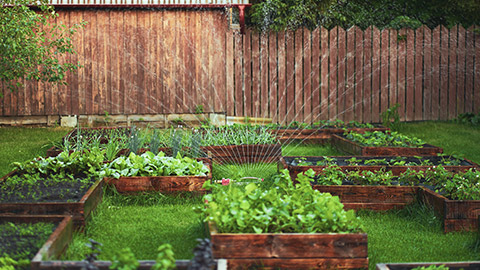
Aim to enable all plants to be self-sustaining once they are mature. This will mean that, apart from extremely dry summers, you’ll only need to water new plants, including annuals and some perennials.
The Auckland Botanic Gardens offers the following advice related to minimising the need for watering plants.
- Carefully select suitable plants for your conditions, especially where soils are sandy.
- Plant frost-hardy plants in autumn to enable establishment during wet winter and spring so they can sustain themselves through the drier summer months.
- Organic matter such as compost or manure added to the soil before planting will improve the ability of soil to absorb and retain water.
- Mulch with organic matter immediately after planting.
- It is better to water thoroughly but seldom rather than apply frequent sprinklings. When watering is necessary, it should moisten the entire root zone. All crops, from trees to annual displays and edible plants, should be watered like this.
- Avoid excessive irrigation, which can lead to dependency on regular applications of water.
TIP: To ensure water doesn't run off the top of the soil when you are hand watering, water first, just to wet the top of the soil, and then come back and water a second time a minute or two later to get deep into the soil.
When using an irrigation system, the same principle – wetting the surface lightly first, then watering deeply – can be achieved by using sprinklers or drip irrigation that applies a smaller amount of water over a longer period of time.
Activity – What does water bring to plant health?
Complete this activity, reminding yourself about the role water plays in plant growth and health.
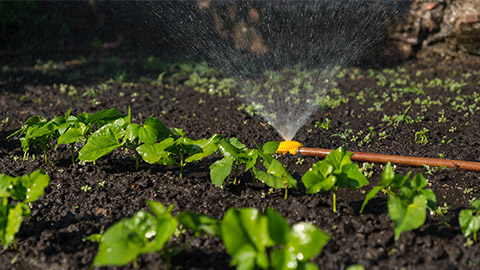
In its most simple form, an irrigation system consists of:
- a water source
- components that apply the water to our chosen plants
- components that move the water from the water source to those that apply the water.
In this section, we are looking at small irrigation systems that would be suitable for a large household garden, a community garden or a small market garden or orchard.
Components of a small irrigation system
Water source
Most likely this will be an outdoor tap that is connected to the house’s main water supply. This could be council-supplied water or rainwater from the house’s water tank.
Or the water may be supplied by one or more smaller water tanks that have been installed for the purpose of providing water for the garden. In either case, it will probably have a tap with a threaded spout.
If you’re using small water tanks, the pressure coming out of the tap will be determined by how full the tank is. If it’s full, it may have enough pressure to run a small irrigation system but when it gets low, it probably won’t. You may need to invest in a small pump.
Moving the water: hose, pipe, and fittings
Sections of hose and pipe are used to transport the water from the source to the components that apply the water to the plants.
| Hose | A flexible tube that can carry water, i.e., a garden hose. It’s easy to roll up on a hose reel, or gather up in loops and carry around. |
| Pipe | A tube that is rigid (or at least more rigid than a hose) that is also used to move water. |
For small irrigation systems, we usually use LDPE (low density polyethylene - sometimes called alkathene) pipes for most parts, as they are lightweight, flexible and relatively low-cost.
Note that LDPE pipe comes in a range of standard sizes, such as 4mm, 13mm, 19mm and 25mm. If you’re buying pipe and fittings, make sure the components you’re buying are compatible.
There are a wide range of fittings used to join sections of pipe together, make sharp turns, and step-down from a larger pipe to a smaller one.
You will also need clamps, and possibly T-shape connectors as well as the elbow connectors, as shown below.
| Item | Product link @Bunnings | Photo |
|---|---|---|
| Hose | Pope 12mm x 20m Heritage Garden Hose | 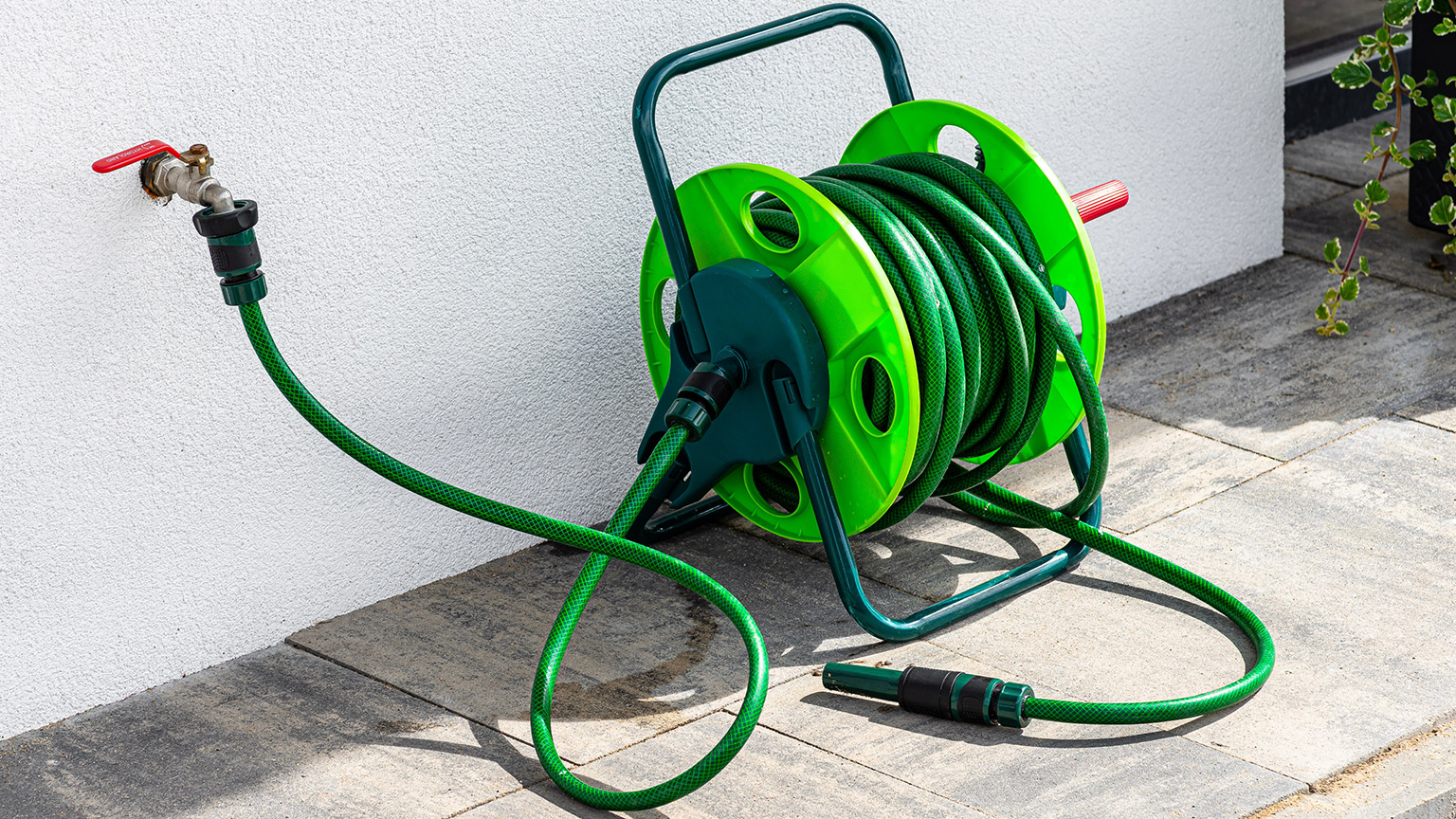 |
| Hose connector | Pope 12mm Universal Tap Adaptor | 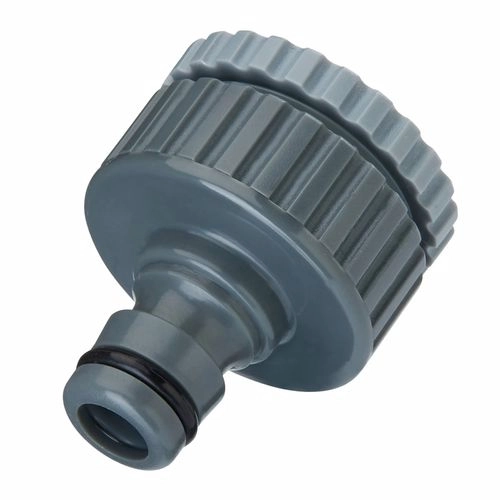 |
| Pipe/Tubing | Holman 25mm x 25m Black Poly Pipe | 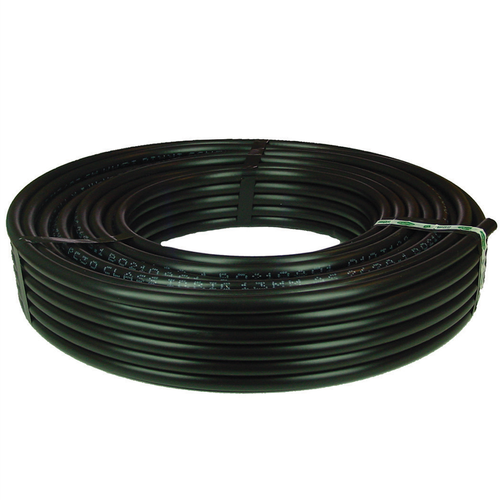 |
| Pipe connector | Pope 25mm Barbed Nut And Tail | 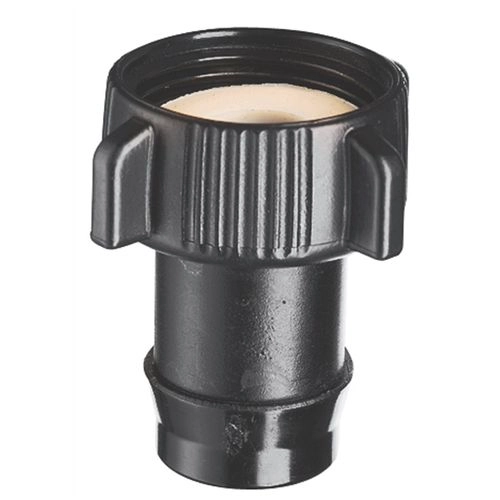 |
| Pipe connector: sharp turn | Pope Male Thread Elbow 19x15mm |  |
| Pipe connector: step down (reducing) | Pope Barbed Reducing Joiner Tee 19x 13mm | 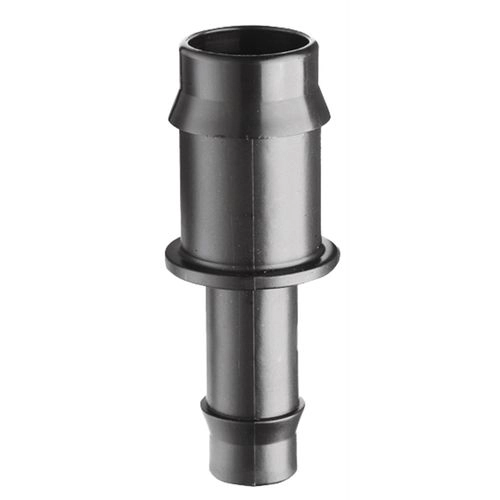 |
Controlling water flow: valves
A valve is the term given to a tap or other device that can be opened to let water flow through, or closed to stop it. Valves come in different types and sizes.
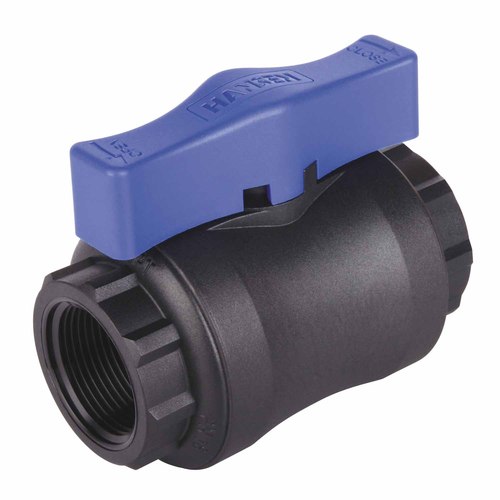
The direction of the handle (the blue part) shows the position of the valve and allows you to open and close the flow of water through it by giving it a quarter twist. It is open if the handle is in line with the hose (as in this photo). If it is across the hose, then it is closed.
Source: Mitre10
They are particularly useful if you don’t have enough water pressure to run your whole irrigation system at once. In this case you can use them to turn off sections of the irrigation system (called blocks) so that all the water pressure is applied to a smaller set of sprinklers. After a period of time you can turn that block off and another block on.
Applying Water: Sprinklers and Drippers
The main types of components for applying water to crops are sprinklers and drippers.
Sprinklers
A sprinkler applies water over a wide area by using the water pressure to spray it through the air allowing it to fall on the plants and soil. Sprinklers can be either spray nozzles or rotary sprinkler heads.
- Spray nozzles – force water out in all directions (although you can get ones that have smaller arcs, like 90, 180 or 270 degrees) as a fine mist which is absorbed into the soil easily. They generally have no moving parts.
- Rotary/oscillating sprinkler heads – spray one or more jets of water out while spinning around to cover the chosen area. The water comes out in larger droplets so water distribution from these is less affected by wind.
Drippers
Drippers apply a small amount of water (one drop every few seconds) directly to the soil.
Drippers come in two styles:
- Drip tape/drip hose/tubing – small holes run the full length of the pipe or hose. These are suitable for closely spaced crops.
- Individual drippers – these are pressed into LDPE pipe at the desired spacings. These are more suitable for plants spaced further apart.
Advantages of drippers
- Because they are placed close to the plant roots, they don’t water areas that don’t need it, such as pathways.
- Because they apply the water directly to the soil, water doesn’t evaporate, which can happen with water applied by sprinklers.
- They don’t need as much pressure to operate.
Disadvantages of drippers
- Drip systems need to be run for a long time to apply as much water as sprinkler systems.
- Because they need to be placed near plant roots, drip lines need to go on the beds, rather than on the pathways, so they need to be moved off the bed before the soil can be cultivated – sharp hoes can easily cut LDPE pipes!
- In sandy soils you may need to run several drip lines for each garden bed because the water will run through the root zone very quickly.
We've selected Bunnings to show you the following products, however, these products should be available at any big box store or gardening specialty shop. We don't endorse using any one of them over another.
| Item | Product link @Bunnings | Photo |
|---|---|---|
| Spray nozzle | 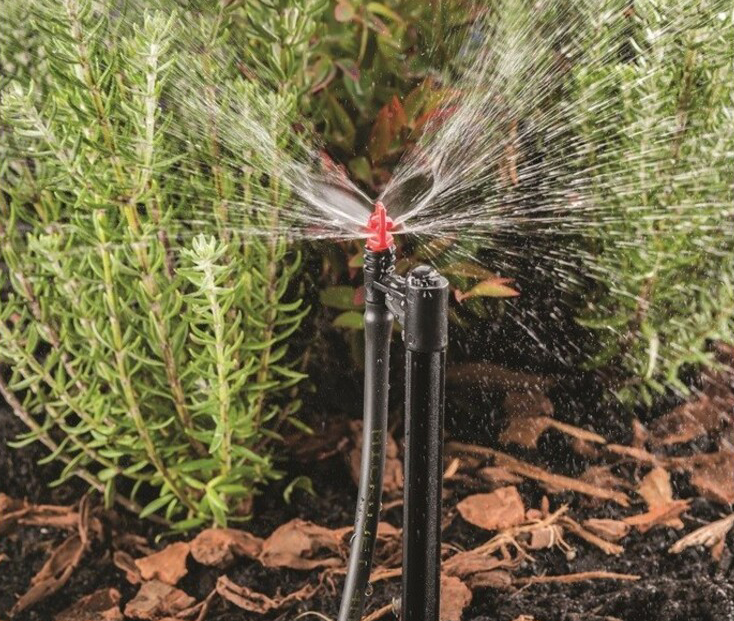 |
|
| Sprinkler head | Pope Metal Impact Sprinkler On Spike | 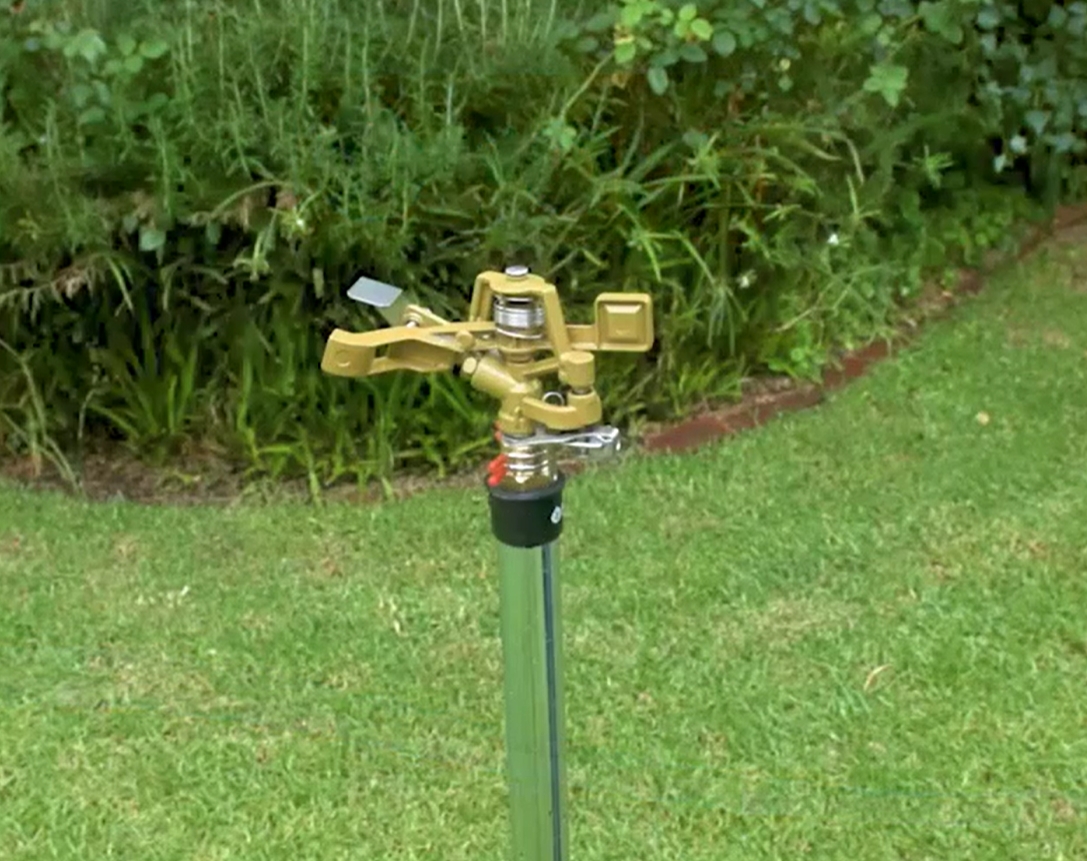 |
| Soaker hose | Holman 20m Fitted Soaker Hose | 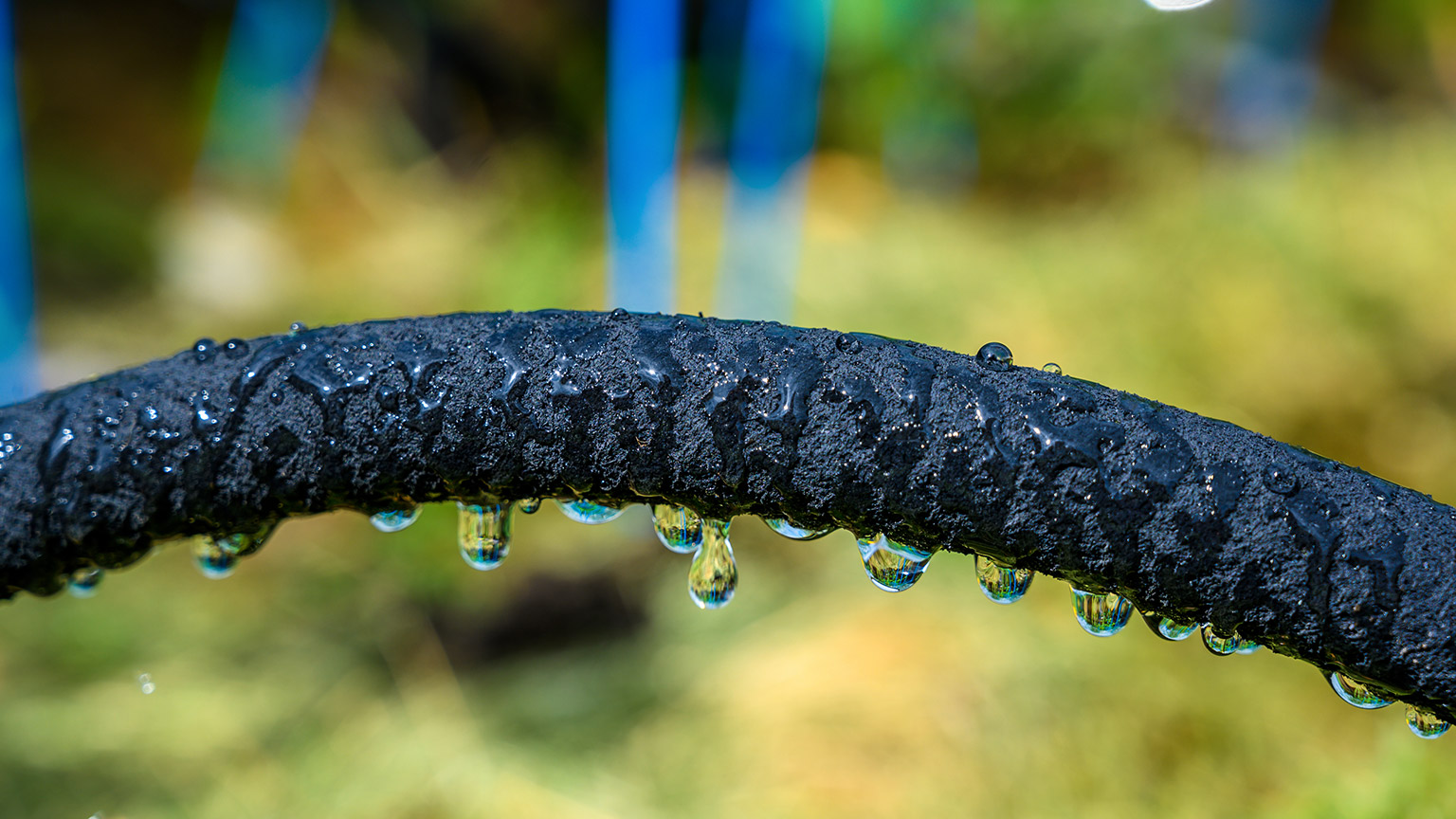 |
| Drip hose/tubing (shown with connector) | Pope 13mm x 30m Drip Eze Drip Irrigation Tube | 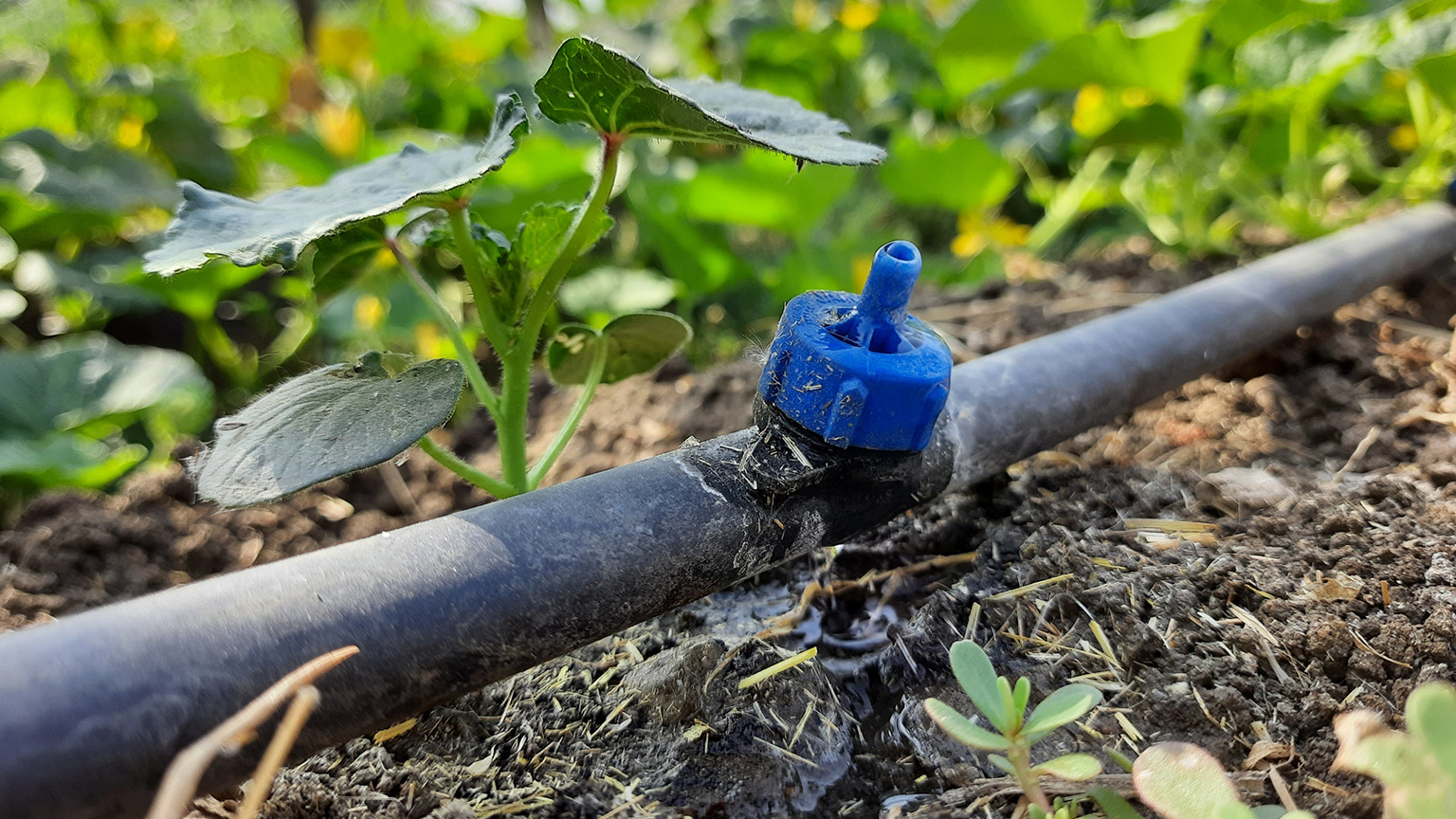 |
Small irrigation system designs
Permanent systems
These are ideal for garden beds that don’t need to be worked with machinery or large hand tools, so they are ideal for ornamental gardens or can be laid along the middle of raised garden beds.
The video below by Mitre 10 (10:13) shows a wide range of different sprinklers, pipes and fittings. If water pressure was an issue, they could run the lawn sprinklers from a different outlet on the three-way splitter. This way they could run the garden sprinklers first and the lawn sprinklers second.
Or better still, do away with the lawn sprinklers as a good way to save water.
Moveable systems
For larger operations, it can be useful to choose a design that can be moved. This way you can move your sprinklers or drip lines out of the way when you need to prep or cultivate the beds, particularly if you need to use machinery such as a rotary hoe.
It also means that you can get by with fewer irrigation system components, but the trade-off is that you’ll spend more time moving the system from place to place.
▶ Market Gardener's Toolkit (optional)
JM shows us the irrigation system used in their market garden.
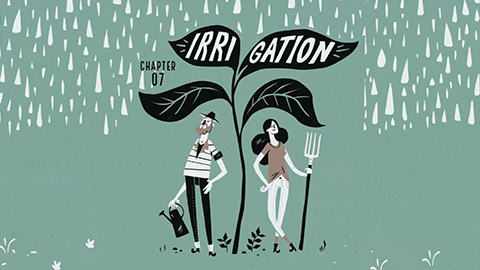
| Heading | Chapter 07: Irrigation |
| Timestamp | 00.00 — 00.00 |
